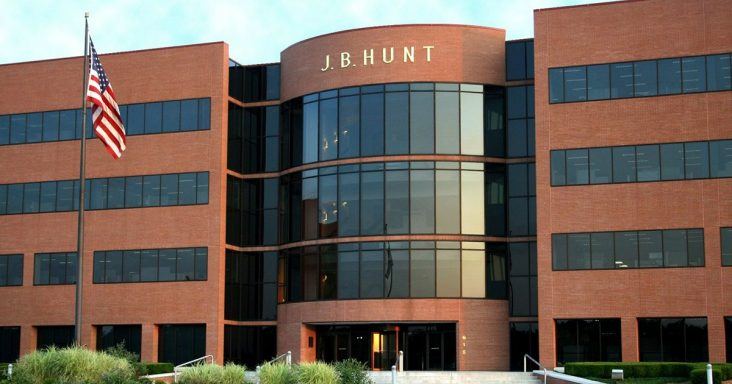J.B. Hunt earnings per share expected to fall 39% in second quarter
by July 7, 2020 1:35 pm 1,610 views

Lowell-based carrier J.B. Hunt Transport Services is expected to report a 39.4% decline in earnings per share for the second quarter of 2020 as freight volumes recovered over the period and analysts provided upgrades to the carrier’s stock.
On July 16, J.B. Hunt expects to release second-quarter earnings after the markets close, and based on a consensus of 20 analysts, earnings per share is projected to fall to 83 cents, from $1.37 in the same period in 2019. Revenue is expected to fall 11.2% to $2.01 billion, from $2.26 billion.
Over the second quarter, three analysts upgraded J.B. Hunt stock to buy, outperform or overweight, from hold, neutral and sector weight, respectively. The following are the analysts and dates of the stock updates: Argus Research, April 17; Baird, May 26; and KeyBanc, June 23.
At the start of the COVID-19 pandemic in mid-March, the stock had closed as low as $75.18. It has since risen and closed July 6 at $120.84 and hit a 52-week high on Tuesday (July 7) at $125.14.
In its report, Baird analysts had increased its 12-month target price for the stock to $125, from $115, and noted that investor sentiment had fallen to the lowest point in a decade. Stock performance and sentiment have been tied to declining growth and margin expectations in the carrier’s intermodal segment, which comprised 52% of its revenue in 2019, said senior research analyst Benjamin Hartford and research analyst Andrew Reed, both with Baird.
U.S. intermodal volumes declined 6.6%, or by 70,994 units, to 1 million containers and trailers in June, from the same month in 2019, according to the Association of American Railroads. Rail and intermodal volumes have been slowly recovering since early May.
“By the end of June, freight loadings had improved by about 60,000 carload and intermodal units weekly over where they had been in late April,” said John Gray, senior vice president of the Association of American Railroads. “Leading the way upward was the intermodal business which, over the last two months, grew to match volumes last seen around the first of February.”
In the first half of 2020, intermodal volumes fell 10.6%, or by 732,697 containers and trailers, from the same period in 2019.
In a separate report, Hartford and Reed said investor sentiment had “firmed up” following the stock upgrade, and rising intermodal volumes in June contributed to the improvement. The risk with regard to second-quarter earnings per share can be attributed to margin pressure in intermodal as a result of “network imbalances,” the analysts said.
J.B. Hunt’s Dedicated Contract Services segment comprised 23% of the carrier’s revenue in 2019, and it recently released a study on handling the transportation needs of Siloam Springs-based poultry producer Simmons Foods. J.B. Hunt started in 2012 to handle transportation needs at a feed mill. The carrier has since added more transportation operations of Simmons Foods.
“Now,” said Wes McClure, senior vice president of operations, “basically everything we do with a truck — J.B. Hunt handles it.”
Simmons has more than 400 farms and plants, 117 tucks and 392 trailers and 145,000 loads per year.
“J.B. Hunt allows us to focus our time, effort and energy on those things that make us most competitive,” said David Jackson, chief operating officer for Simmons Foods. “They move product between our facilities, they do that cost competitively and reliably, and then we can focus on the things we do well that set us apart from our competitors.”
Other J.B. Hunt business segments include brokerage, final mile and truck, and they comprised 15%, 6% and 4%, respectively, of revenue in 2019.
Between January and May, truck tonnage has fallen 2.6%, from the same period in 2019, according to American Trucking Associations (ATA).
“While the overall economy will likely take more than a year to recover, assuming the pandemic doesn’t spike again, the trucking industry could recover back to pre-COVID levels before many other industries because it hasn’t fallen as much,” said ATA Chief Economist Bob Costello. “As retail sales improve and housing starts recover, that will help trucking. The risk for trucking is that the virus surges again and places start to shut back down again.”
Freight volumes were up 45% in the week leading into Independence Day, from the same week in 2019, according to FreightWaves. Its Outbound Tender Volume Index rose to nearly 13,000 for the second time in the past three years. The first time it reached that level was in March during the panic buying spree.
Dry-van spot rates rose 13.3% in June, from May, according to DAT Solutions. The rates were down 4.3% in June, from the same month in 2019.
